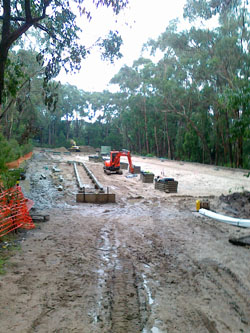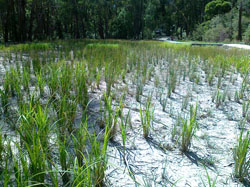resource library
Array
Boardwalks provide access to the bio-infiltration system

Construction phase

New plants within raingarden
Wicks Reserve Bio-Infiltration Basin
Knox City Council
Wicks Reserve, The Basin, Victoria | Map:
Published: 17 May 2012
Project Overview
The Wicks Reserve Bio-Infiltration System is an innovative bio-infiltration system that aims to protect Dobson’s Creek, a waterway of high ecological significance, from the degrading impacts of urbanisation. The system combines bio-filtration, infiltration and harvesting of stormwater, and contributes to restoring both the water quality and flow regime of the creek back towards its natural ‘pre-development’ state.
The bio-infiltration basin is located within Wicks Reserve – situated only 200m away from Dobson’s Creek – in the Knox municipality area. Wicks reserve is a site of high biological significance due to (1) the presence of depleted and vulnerable Ecological Vegetation Classes (e.g. Wet Heathland, Swampy Woodland and Grassy Forest), (2) a large, breeding population of the Swordgrass Brown butterfly and (3) excellent birdlife.
The system intercepts stormwater flows from two pipes draining the 11.5ha impervious urbanised catchment to the South of Wicks Reserve. Whilst part of the stormwater is lost through evapotranspiration, most filters through the vegetated filtration media into the base of the system – a 300mm layer of scoria. This base layer facilitates infiltration into the surrounding soil and creates a large storage area for the treated stormwater (1.5ML). This water can be pumped out of the system and used to supply a 23kL tank, which in turn provides filtered water for toilet flushing and to irrigate the surrounding forested area.
The project was an initiative driven by Knox’s Water Sensitive Urban Design (WSUD) and Stormwater Management Strategy and is part of the Dobson’s Creek catchment disconnection project. It won the Stormwater Victoria Excellence in Infrastructure Award in 2011.
Drivers and Objectives
The main objective of the project was to improve the ecological condition of Dobson’s Creek, by protecting it from the impacts of urbanisation and aiming to restore it to its ‘natural’ state - where platypus could return to the area. Meeting this objective involves:
- Restoring the hydrology of the creek back towards its natural ‘pre-development’ state (increased baseflows and reduced frequency, rates and volumes of runoff), and
- Reducing the concentrations and loads of sediment, nutrients, heavy metals and toxicants entering the creek.
Given the extremely high ecological value of Wicks Reserve, another key objective of this project was the protection and enhancement of the terrestrial ecological values of the site.
A secondary objective of this project was to provide access to water for irrigation of the surrounding forest and toilet flushing through a novel stormwater harvesting system, using the large storage volume available within the base of the infiltration system (thus avoiding the need to construct a major separate storage).
Finally, community awareness and engagement were recognised as an objective of this project. The community was consulted about the project, information was placed on the web and the community was invited to an opening event to inaugurate the site.
Organisations
Knox City Council (Responsible Council)
MonashUniversity(Design Partner)
The University of Melbourne (Design Partner)
Contek Constructions (Construction)
Melbourne Water (Funding Partner)
Project Outcomes
MUSIC modeling shows that the system will achieve very high environmental outcomes (far exceeding the benchmarks set for best practice stormwater management), and monitoring is currently being undertaken to confirm this.
The harvested stormwater is used to irrigate adjacent forested areas and therefore contributes to the ecological health of the reserve.
The undulating surface of the bio-infiltration basin provided opportunities for different plant species to thrive within different parts of the system resulting in a more diverse plant mix. A local ecologist provided specialist advice on the plant species mix, which contains vegetation representative of the Ecological Vegetation Classes of the area.
The project team encouraged community awareness and engagement at different stages throughout the project:
- A community consultation process was developed at the concept phase of the project.
- The construction contractor provided information during construction to visitors to the site.
- An opening BBQ allowed over 60 members of the community to celebrate the completion of the project.
- Interpretive signage was installed on-site after completion of the project.
The new design of the raingarden has enhanced the public realm within Wicks Reserve improving access with an all weather surface for walking (boardwalk) and public seating area.
The project also brought about a positive social outcome. More people use the reserve to enjoy the ambience of the ‘wetland’ and walk around the boardwalk, increasing the passive surveillance within the reserve.
Lessons Learnt
Several different areas of council participated in the design of the system, which fostered innovation and greatly improved the quality of the design. Maintenance staff were involved from the onset and provided input into the design. This helped inform maintenance costs and the ongoing maintenance requirements of the system. Furthermore, the biodiversity section suggested the idea of designing the undulating surface, allowing a larger diversity of plants to be incorporated into the design.
The use of ‘unit rates’ for the estimation of construction and maintenance costs during the design and planning phase greatly facilitated project planning and tracking of funding allocations.
Sealing an unforeseen leak in the system after planting of the bio-infiltration system created a lot of sediment runoff into the basin, which impacted on plant growth and subsequent infiltration rates.
Fairly intensive vegetation maintenance was required for the first year of operation, but now the plants have established and matured it is envisaged this will drop back. The maintenance team now has a checklist of activities to carry out every 6 weeks.
The success of this project has paved the way for other initiatives to achieve similar outcomes. Two such examples are Knox’s road re-construction projects (Raingardens for helping your creek) and Melbourne Water and South East Water’s household tank give-away scheme (Tanks for helping your creek) to reduce the volumes of stormwater directly entering creeks.
Project Cost
$745,000 Total, including funding of $585,000 from Melbourne Water
Timeframe
2009 – Planning (in concert with Knox WSUD and Stormwater Management Strategy 2010)
2010 – Design and Tender
2011 – Construction
Contact
Daniella Gerente – Knox City Council
T 03 9298 8881
